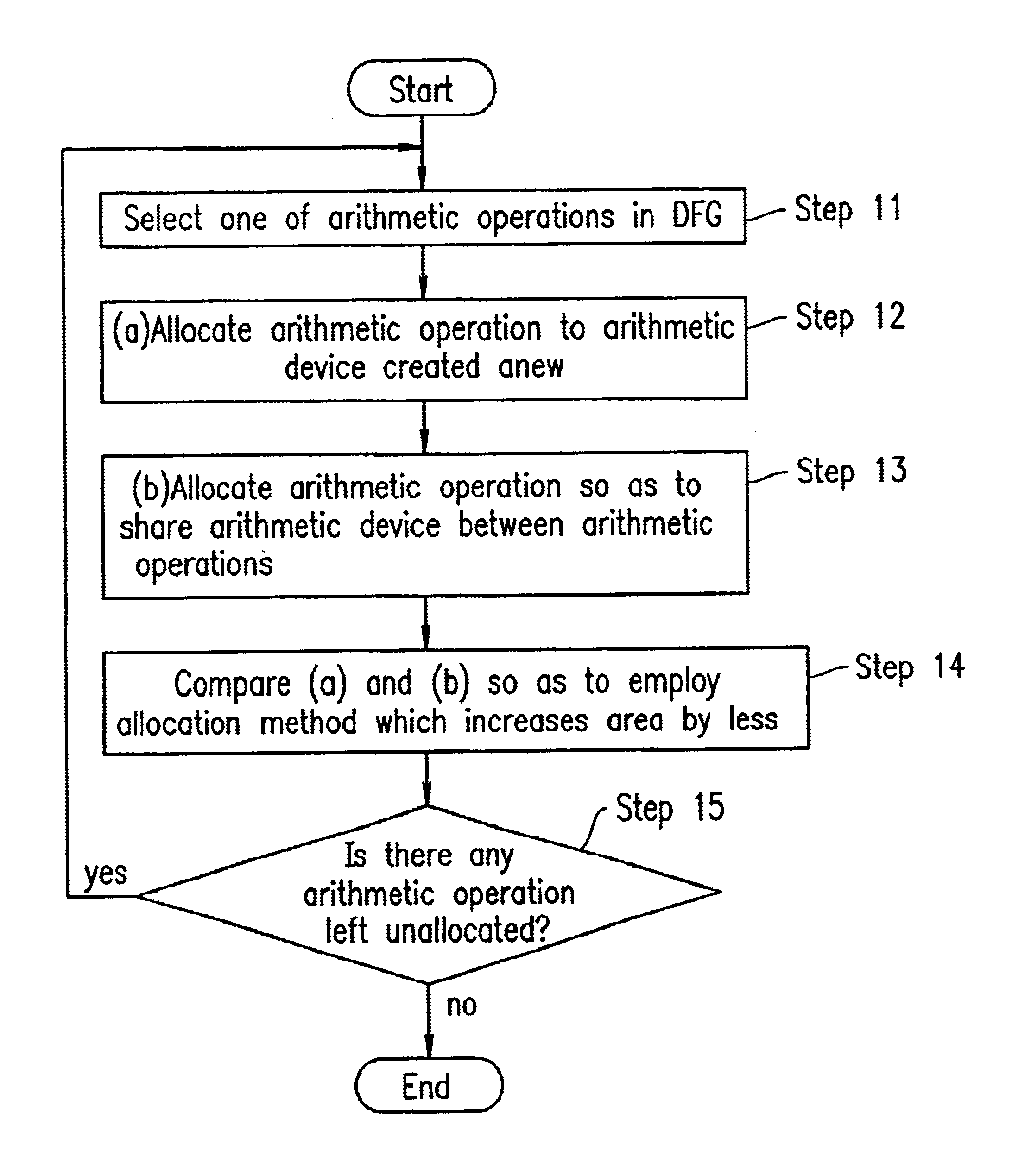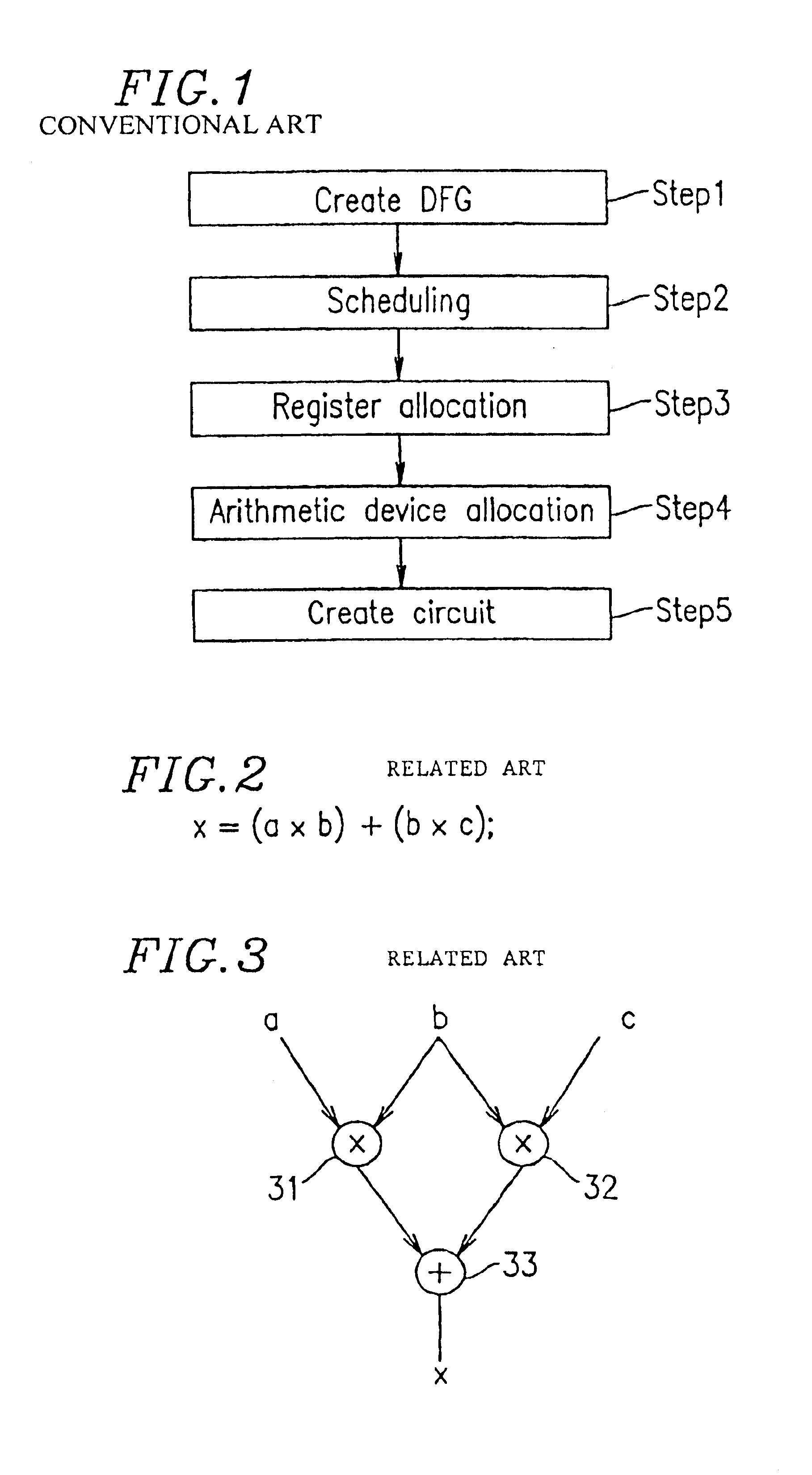Method for designing arithmetic device allocation
a technology of arithmetic device and allocation method, which is applied in the direction of program control, computation using denominational number representation, instruments, etc., can solve the problems of preventing correct evaluation of logic synthesis steps, circuit malfunction, and increase power consumption, so as to minimize the increase in the circuit area, increase the total circuit area, and reduce the number of selectors
- Summary
- Abstract
- Description
- Claims
- Application Information
AI Technical Summary
Benefits of technology
Problems solved by technology
Method used
Image
Examples
embodiment 1
(Embodiment 1)
[0099]FIG. 16 is a flowchart for explaining an arithmetic device allocation design method according to Embodiment 1 of the present invention. In Embodiment 1, arithmetic operations in a data flow graph (DFG) are allocated to corresponding arithmetic devices one by one based on a scheduling result.
[0100]At step 11, one of the arithmetic operations in the DFG is selected. The following two methods (a) and (b) are respectively attempted at steps 12 and 13: (a) the arithmetic operation selected at step 11 is allocated to an arithmetic device created anew; and (b) an arithmetic operation is allocated to an arithmetic device to which another arithmetic operation has already been allocated so as to share the arithmetic device between these arithmetic operations. In such a case of allocating an arithmetic operation to an arithmetic device to which another operation has already been allocated so as to share the arithmetic device between these arithmetic operations, a selector i...
embodiment 2
(Embodiment 2)
[0119]FIG. 24 is a flowchart for explaining an arithmetic device allocation design method according to Embodiment 2. Embodiment 2 prevents the loop including only a combination circuit as shown in FIG. 13 from being generated when an arithmetic operation in the DFG is allocated to an arithmetic device based on a scheduling result.
[0120]Firstly, as a preparatory step, data dependency between arithmetic operations is examined according to a procedure as follows. At step 21, all the arithmetic operations to be allocated to arithmetic devices are detected from the DFG based on scheduling and register allocation results so as to be listed as focused arithmetic operations. Here, as shown in FIG. 25, each arithmetic device 141-144 is listed as a focused arithmetic operation based on, for example, the scheduling result of FIG. 12.
[0121]Next, at step 22, a pre-arithmetic operation or a post-arithmetic operation is determined with respect to each focused arithmetic operation. Th...
embodiment 3
(Embodiment 3)
[0136]FIG. 31 is a flow chart for explaining an arithmetic device allocation design method according to Embodiment 3. A false path refers to a path on which no operation is actually performed, and therefore no problems are caused to a circuit itself if the false circuit is present in the circuit. However, a conventional design verification tool cannot determine whether a path is a false path or a path on which any operation is actually performed, and thus detects the false path only as an error, thereby causing problems. Embodiment 3 prevents the generation of the false path causing a delay greater than a designated value when allocating the arithmetic operations to the arithmetic devices.
[0137]Firstly, when allocating a plurality of arithmetic operations to a single arithmetic device, it is checked whether or not a false path causing a delay is greater than a designated value.
[0138]At step 31 in FIG. 31, all the arithmetic operations to be allocated to an arithmetic d...
PUM
 Login to view more
Login to view more Abstract
Description
Claims
Application Information
 Login to view more
Login to view more - R&D Engineer
- R&D Manager
- IP Professional
- Industry Leading Data Capabilities
- Powerful AI technology
- Patent DNA Extraction
Browse by: Latest US Patents, China's latest patents, Technical Efficacy Thesaurus, Application Domain, Technology Topic.
© 2024 PatSnap. All rights reserved.Legal|Privacy policy|Modern Slavery Act Transparency Statement|Sitemap



